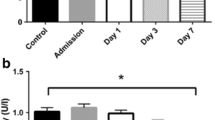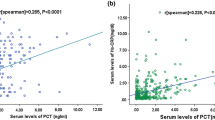Abstract
Prolyl carboxypeptidase (PRCP) is an enzyme associated with cerebrovascular risk factors such as hypertension, diabetes mellitus, obesity and hyperlipidemia. We aim to evaluate the relation between serum PRCP activity and severity, evolution and outcome of acute ischemic stroke. We used a specific RP-HPLC activity assay to measure PRCP activity in serum of 50 stroke patients at admission, and at 24 h, 72 h and 7 days after stroke onset to assess correlations with stroke severity based on the National Institutes of Health Stroke scale score (NIHSS), infarct volume on brain MRI scan, stroke outcome based on the modified Rankin scale (mRS) and mortality at 3 months after stroke. The average PRCP activity in serum decreased significantly the first 24 h after stroke onset and returned to baseline values at day 7. High NIHSS scores and infarct volumes at admission were related with a more pronounced decrease of PRCP in the first 24 h after stroke (ΔPRCP24, r = 0.31, P < 0.05; r = 0.30, P < 0.05). In addition, patients who displayed a more pronounced decrease in PRCP levels during the first 24 h after stroke were more likely to be institutionalized upon discharge (n = 21) (ΔPRCP24 ± SD, 0.05 ± 0.10 U/L vs. 0.17 ± 0.14 U/L, P = 0.001). The decrease in PRCP levels in the first 24 h after stroke onset is associated with stroke severity and an unfavourable short-term stroke outcome.



Similar content being viewed by others
Abbreviations
- proCPU:
-
Procarboxypeptidase U
- PRCP:
-
Prolyl carboxypeptidase
- Ang-(1-8):
-
Angiotensin-(1-8)
- Ang-(1-7):
-
Angiotensin-(1-7)
- TOAST:
-
Trial of Org 10172 in Acute Stroke Treatment
- CRP:
-
C-reactive protein
- NIHSS:
-
National Institutes of Health Stroke Scale
- EPSS:
-
European Progressing Stroke Study
- mRS:
-
Modified Rankin scale
References
Donnan GA, Fisher M, Macleod M, Davis SM (2008) Stroke Lancet 371:1612–1623
Go AS, Mozaffarian D, Roger VL, Benjamin EJ, Berry JD, Turner MB et al (2013) Heart disease and stroke statistics–2013 update: a report from the American Heart Association. Circulation 127:e6–e245
Brouns R, De Deyn PP (2009) The complexity of neurobiological processes in acute ischemic stroke. Clin Neurol Neurosurg 111:483–495
Dirnagl U, Iadecola C, Moskowitz MA (1999) Pathobiology of ischaemic stroke: an integrated view. Trends Neurosci 22:391–397
Sugawara T, Fujimura M, Noshita N, Kim GW, Saito A, Hayashi T, Narasimhan P, Maier CM, Chan PH (2004) Neuronal death/survival signaling pathways in cerebral ischemia. NeuroRx 1:17–25
Brouns R, Heylen E, Willemse JL, Sheorajpanday R, De Surgeloose D, Verkerk R, De Deyn PP, Hendriks DF (2010) The decrease in procarboxypeptidase U (TAFI) concentration in acute ischemic stroke correlates with stroke severity, evolution and outcome. J Thromb Haemost 8:75–80
O’Donoghue AJ, Eroy-reveles AA, Knudsen GM, Ingram J, Zhou M, Statnekov JB, Greninger AL, Hostetter DR, Qu G, Maltby DA, Anderson MO, DeRIsi JL, Mckerrow JH, Burlingame AL, Craik CS (2013) Global identification of peptidase specificity by multiplex substrate profiling. Nat Methods 9:1095–1100
Mallela J, Yang J, Shariat-Madar Z (2009) Prolylcarboxypeptidase: a cardioprotective enzyme. Int J Biochem Cell Biol 41:477–481
Skidgel RA, Erdös EG (1998) Cellular carboxypeptidases. Immunol Rev 161:129–141
Shariat-Madar Z, Mahdi F, Schmaier AH (2004) Recombinant prolylcarboxypeptidase activates plasma prekallikrein. Blood 103:4554–4561
Chajkowski SM, Mallela J, Watson DE, Wang J, McCurdy CR, Rimoldi JM, Shariat-Madar Z (2011) Highly selective hydrolysis of kinins by recombinant prolylcarboxypeptidase. Biochem Biophys Res Commun 405:338–343
Shariat-Madar Z, Rahimy E, Mahdi F, Schmaier AH (2005) Overexpression of prolylcarboxypeptidase enhances plasma prekallikrein activation on Chinese hamster ovary cells. Am J Physiol Heart Circ Physiol 289:H2697–H2703
Wallingford N, Perroud B, Gao Q, Coppola A, Gyengesi E, Liu ZW, Goa XB, Diament A, Haus KA, Shariat-Madar Z, Mahdi F, Wardlaw SL, Schmaier AH, Warden CH, Diano S (2009) Prolylcarboxypeptidase regulates food intake by inactivating α-MSH in rodents. J Clin Invest 119:2291–2303
Palmiter RD (2009) Reduced levels of neurotransmitter-degrading enzyme PRCP promote obesity. J Clin Invest 119:2130–2133
Adams GN, LaRusch GA, Stavrou E, Zhou Y, Nieman MT, Jacobs GH, Cui Y, Lu Y, Jain MK, Mahdi F, Shariat-Madar Z, Okada Y, D’Alecy LG, Schmaier AH (2011) Murine prolylcarboxypeptidase depletion induces vascular dysfunction with hypertension and faster arterial thrombosis. Blood 117:3929–3937
Wang L, Feng Y, Zhang Y, Zhou H, Jiang S, Niu T, Wei LJ, Xu X, Xu X, Wang X (2006) Prolylcarboxypeptidase gene, chronic hypertension, and risk of preeclampsia. Am J Obstet Gynecol 195:162–171
Ngo ML, Mahdi F, Kolte D, Shariat-Madar Z (2009) Upregulation of prolylcarboxypeptidase (PRCP) in lipopolysaccharide (LPS) treated endothelium promotes inflammation. J Inflamm 6:3
Zhu L, Carretero OA, Liao TD, Harding P, Li H, Sumners C, Yang XP (2010) Role of prolylcarboxypeptidase in angiotensin II type 2 receptor-mediated bradykinin release in mouse coronary artery endothelial cells. Hypertension 56:384–390
Zhang Y, Hong XM, Xing HX, Li JP, Huo Y, Xu XP (2009) E112D polymorphism in the prolylcarboxypeptidase gene is associated with blood pressure response to benzapril in Chinese hypertensive patients. Chin Med J 122:2461–2465
Xu S, Lind L, Zhao L, Lindahl B, Venge P (2012) Plasma prolylcarboxypeptidase (angiotensinase C) is increased in obesity and diabetes mellitus and related to cardiovascular dysfunction. Clin Chem 58:1110–1115
Rabey FM, Gadepalli RSVS, Diano S, Cheng Q, Tabrizian T, Gailani D, Rimoldi JM, Shariat-Madar Z (2012) Influence of a novel inhibitor (UM8190) of prolylcarboxypeptidase (PRCP) on appetite and thrombosis. Curr Med Chem 19:4194–4206
Renna R, Pilato F, Profice P, Marca GD, Broccolini A, Morosetti R, Frisullo G, Rossi E, De Stefano V, Di Lazzaro V (2014) Risk factor and etiology analysis of ischemic stroke in young adult patients. J Stroke Cerebrovasc Dis 23:1–7
Shariat-Madar Z, Mahdi F, Schmaier AH (2002) Identification and characterization of prolylcarboxypeptidase as an endothelial cell prekallikrein activator. J Biol Chem 277:17962–17969
Kehoe K, Verkerk R, Sim Y, Waumans Y, Van der Veken P, Lambeir AM, De Meester I (2013) Validation of a specific prolylcarboxypeptidase activity assay and its suitability for plasma and serum measurements. Anal Biochem 443:232–239
Jeong JK, Diano S (2014) Prolyl carboxypeptidase mRNA expression in the mouse brain. Brain Res 1542:85–92
Buga AM, Scholz CJ, Kumar S, Herndon JG, Alexandru D, Cojocaru GR, Dandekar T, Popa-Wagner A (2012) Identification of new therapeutic targets by genome-wide analysis of gene expression in the ipsilateral cortex of aged rats after stroke. PLoS One 7:e50985
Adams GN, Stavrou EX, Fang C, Merkulova A, Alaiti MA, Nakajima K, Morooka T, Merkulov S, LaRusch GA, Simon DI, Jain MK, Schmaier AH (2013) Prolylcarboxypeptidase promotes angiogenesis and vascular repair. Blood 122:1522–1531
Willemse JL, Brouns R, Heylen E, De Deyn PP, Hendriks DF (2008) Carboxypeptidase U (TAFIa) activity is induced in vivo in ischemic stroke patients receiving thrombolytic therapy. J Thromb Haemost 6:200–202
Brouns R, Heylen E, Sheorajpanday R, Willemse JL, Kunnen J, De Surgeloose D, Hendriks DF, De Deyn PP (2009) Carboxypeptidase U (TAFIa) decreases the efficacy of thrombolytic therapy in ischemic stroke patients. Clin Neurol Neurosurg 111:165–170
Brouns R, Sheorajpanday R, Wauters A, De Surgeloose D, Mariën P, De Deyn PP (2008) Evaluation of lactate as a marker of metabolic stress and cause of secondary damage in acute ischemic stroke or TIA. Clin Chim Acta 397:27–31
Brouns R, Marescau B, Possemiers I, Sheorajpanday R, De Deyn PP (2009) Dimethylarginine levels in cerebrospinal fluid of hyperacute ischemic stroke patients are associated with stroke severity. Neurochem Res 34:1642–1649
Adams HP, Bendixen BH, Kappelle LJ, Biller J, Love BB, Gordon DL, Marsh EE (1993) Classification of subtype of acute ischemic stroke. Definitions for use in a multicenter clinical trial. TOAST. Trial of Org 10172 in Acute Stroke Treatment. Stroke 24:35–41
Birschel P, Ellul J, Barer D (2004) Progressing stroke: towards an internationally agreed definition. Cerebrovasc Dis 17:242–252
Uyttenboogaart M, Luijckx GJ, Vroomen PCAJ, Stewart RE, De Keyser J (2007) Measuring disability in stroke: relationship between the modified Rankin scale and the Barthel index. J Neurol 254:1113–1117
Selim M, Savitz S, Linfante I, Caplan L, Schlaug G (2005) Effect of pre-stroke use of ACE inhibitors on ischemic stroke severity. BMC Neurol 5:10
Manabe Y, Kono S, Tanaka T, Narai H, Omori N (2009) High blood pressure in acute ischemic stroke and clinical outcome. Neurol Int 1:e1
Lu J, Jiang T, Wu L, Gao L, Wang Y, Zhou F, Zhang S, Zhang Y (2013) The expression of angiotensin-converting enzyme 2-angiotensin-(1-7)-Mas receptor axis are upregulated after acute cerebral ischemic stroke in rats. Neuropeptides 47:289–295
Gironacci MM, Carbajosa NAL, Goldstein J, Cerrato BD (2013) Neuromodulatory role of angiotensin-(1-7) in the central nervous system. Clin Sci (Lond) 125:57–65
Mecca AP, Regenhardt RW, O’Connor TE, Joseph JP, Raizada MK, Katovich MJ, Sumners C (2011) Cerebroprotection by angiotensin-1-7 in endothelin-1-induced ischaemic stroke. Exp Physiol 96:1084–1096
Blum A, Vaispapir V, Keinan-Boker L, Soboh S, Yehuda H, Tamir S (2012) Endothelial dysfunction and procoagulant activity in acute ischemic stroke. J Vasc Interv Neurol 5:33–39
Acknowledgments
The authors gratefully thank Nicole Lamoen for excellent technical assistance, Lesley Baerts and Jill Luyckx for logistic support with blood samples. This work was supported by the Fund for Scientific Research Flanders (Belgium, FWO–Vlaanderen) and the University of Antwerp Research Fund. Kaat Kehoe is a research assistant for FWO–Vlaanderen (Grant 11E4613N). This study was also supported by: the Institute Born-Bunge; the agreement between the Institute Born-Bunge and the University of Antwerp; Interuniversity Poles of Attraction (IAP Network P7/16) of the Belgian Federal Science Policy Office; the Flemish Government initiated Methusalem excellence grant, Belgium; and the Medical Research Foundation Antwerp.
Conflict of interest
The authors declare that they have no conflict of interest.
Author information
Authors and Affiliations
Corresponding author
Electronic supplementary material
Below is the link to the electronic supplementary material.
Rights and permissions
About this article
Cite this article
Kehoe, K., Brouns, R., Verkerk, R. et al. Prolyl Carboxypeptidase Activity Decline Correlates with Severity and Short-Term Outcome in Acute Ischemic Stroke. Neurochem Res 40, 81–88 (2015). https://doi.org/10.1007/s11064-014-1468-y
Received:
Revised:
Accepted:
Published:
Issue Date:
DOI: https://doi.org/10.1007/s11064-014-1468-y




